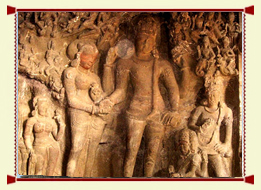 About Ajanta Ellora Caves About Ajanta Ellora Caves
Located near the city of Aurangabad in Maharashtra, the famous Ajanta Ellora caves are shrines cut out of rock, by hand, and rank amongst some of the most outstanding specimens of ancient Indian architectural heritage. The 34 caves at Ellora and the 29 caves at Ajanta, remained shrouded in obscurity for over a millennium, till John Smith, a British Army Officer, accidentally stumbled upon them while on a hunting expedition in 1819. Ajanta has been designated as a World Heritage Site, to be preserved as an artistic legacy that will come to inspire and enrich the lives of generations to come.
Ajanta Caves
It was only in the 19th century, that the group of Ajanta caves, lying deep within the Sahyadri hills, cut into the curved mountain side, above the Waghora river, were discovered. They depict the story of Buddhism, spanning a period from 200 BC to 650 AD.
The 29 Ajanta caves were built as secluded retreats of the Buddhist monks, who taught and performed rituals in the Chaityas and Viharas, the ancient seats of learning, and nerve - centers of the Buddhist cultural movement. Using simple tools like hammer and chisel, the monks carved out the impressive figures adorning the walls of these structures. Many of the caves house panels depicting stories from the Jatakas, a rich mine of tales of the several incarnations of the Buddha. Images of nymphs and princesses amongst others, are also elaborately portrayed.
Ellora Caves
The Ellora caves, 34 in number, are carved into the sides of a basaltic hill, 30 kms from Aurangabad. The finest specimens of cave - temple architecture, they house elaborate facades and exquisitely adorned interiors. These structures representing the three faiths of Hinduism, Buddhism and Jainism, were carved during the 350 AD to 700 AD period. The 12 caves to the south are Buddhist, the 17 in the centre dedicated to Hinduism, and the 5 caves to the north are Jain.
The sculpture in the Buddhist caves accurately convey the nobility, grace and serenity inherent in the Buddha. Caves 6 and 10 house images from the Buddhist and Hindu faith, under the same roof, the latter dedicated to Vishwakarma, the patron saint of Indian craftsmen. The Vishvakarma cave is both a Chaitya and a Vihara, with a seated Buddha placed in the stupa. Its two - storied structure sports a colourful pageant of dwarfs, dancing and making music.
 |